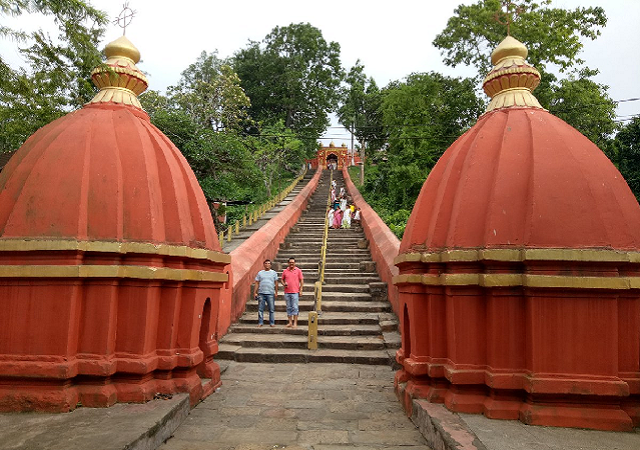Hajo
Published on February 05, 2025
Hajo: A Confluence of Faiths in the Heart of Assam
Hajo, a small town nestled on the banks of the Brahmaputra River in Assam, India, is a place where diverse faiths converge, creating a unique tapestry of religious harmony. This unassuming town holds immense spiritual significance for Hindus, Muslims, and Buddhists, making it a remarkable example of India's syncretic culture. Hajo is not just a collection of temples and mosques; it's a living testament to the peaceful coexistence of different religions, a place where shared beliefs and common ground transcend religious boundaries.
A Meeting Point of Pilgrimage:
Hajo's spiritual importance stems from the presence of several significant religious sites, each revered by different faiths. This confluence of pilgrimage routes makes Hajo a unique destination, attracting devotees from all walks of life.
- Hayagriva Madhava Temple: This Hindu temple, perched atop Nilachal Hill, is dedicated to Lord Vishnu in his Hayagriva (horse-headed) avatar. It's a major pilgrimage site for Vaishnavites and is known for its intricate carvings and sculptures. The temple's location on the hilltop offers panoramic views of the surrounding landscape.
- Powa Mecca: Powa Mecca, meaning "one-fourth of Mecca," is a revered Muslim pilgrimage site. It's a mosque and a complex believed to contain the grave of a Sufi saint. While not as grand as the Hayagriva Madhava Temple, Powa Mecca holds immense spiritual significance for Muslims in the region. The shared reverence between communities for this site further exemplifies Hajo's interfaith harmony.
- Buddhist Connection: While less prominent than the Hindu and Muslim sites, Hajo also has a connection to Buddhism. While no major Buddhist temple exists, the area is believed to have been visited by Buddha, adding another layer to its spiritual significance.
A Tapestry of Shared Beliefs:
What makes Hajo truly special is the shared reverence and respect between the different religious communities. Devotees often visit all three sites, regardless of their own faith, demonstrating a remarkable spirit of religious tolerance. This shared devotion is a testament to the deep-rooted syncretism that characterizes Assamese culture.
The concept of shared sacred spaces is not uncommon in India, but Hajo's example is particularly striking. The town's history is intertwined with stories of interfaith cooperation and mutual respect. Local legends speak of shared festivals and joint efforts to maintain the religious sites. This spirit of harmony is palpable in Hajo, creating a unique atmosphere of peace and understanding.
Exploring the Sites:
- Hayagriva Madhava Temple: The temple's architecture is a blend of Assamese and other regional styles. The main deity is Hayagriva Madhava, depicted in a unique horse-headed form. The temple complex also houses shrines dedicated to other deities. The climb to the temple offers scenic views of the surrounding countryside.
- Powa Mecca: The mosque complex is a peaceful place of prayer and reflection. The architecture is simple yet elegant, reflecting the Sufi tradition. Visitors are welcome to visit the mosque and learn about its history and significance.
Beyond the Religious Sites:
Hajo offers more than just religious sites. The town itself is a charming place to explore, with its traditional Assamese houses, bustling markets, and friendly locals. The Brahmaputra River adds to the town's scenic beauty, offering opportunities for boat rides and enjoying the riverside views.
Planning Your Hajo Visit:
- Reaching Hajo: Hajo is easily accessible from Guwahati, the capital of Assam. It's a short drive or bus ride from Guwahati. Taxis and auto-rickshaws are also readily available.
- Best Time to Visit: The best time to visit Hajo is during the winter months, from October to March, when the weather is pleasant.
- Respecting Religious Sentiments: When visiting the religious sites, it's important to dress modestly and be respectful of the local customs and traditions. Photography may be restricted in some areas.
- Exploring the Town: Take some time to explore the town beyond the religious sites. Wander through the markets, interact with the locals, and experience the unique atmosphere of Hajo.
Hajo: A Symbol of Harmony:
Hajo is more than just a town; it's a symbol of religious harmony, a place where different faiths coexist peacefully and respectfully. It's a testament to the syncretic traditions of Assam and a reminder of the importance of interfaith dialogue and understanding. A visit to Hajo is not just a sightseeing trip; it's an opportunity to witness the power of shared beliefs and the beauty of religious tolerance. It's an experience that will leave you with a sense of hope and a deeper appreciation for India's rich cultural heritage.
